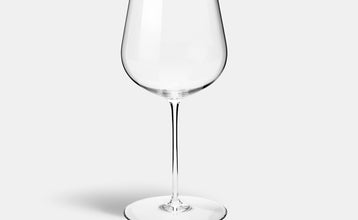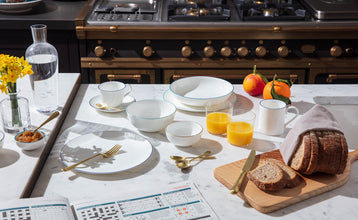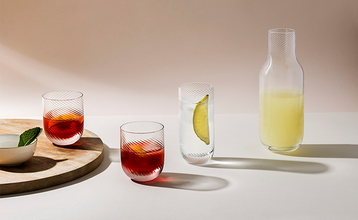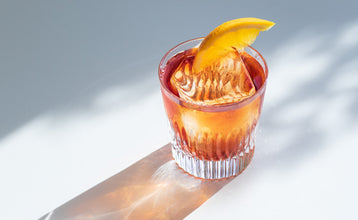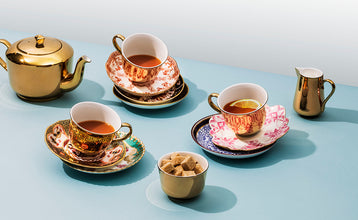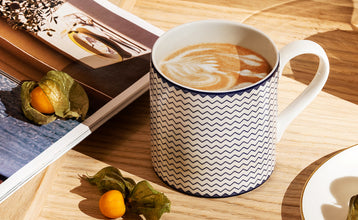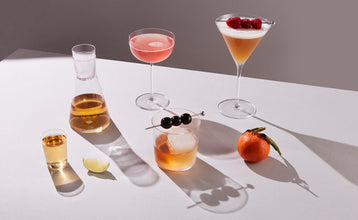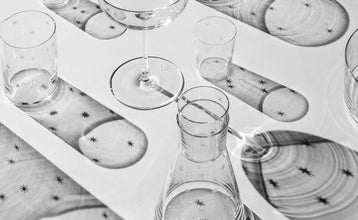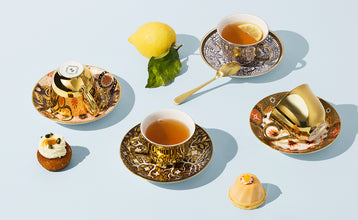
21/09/19
Discover the Jancis Robinson collection
Jancis, you’ve publicly declared that all wines should be treated with equal respect, and that just one wine glass will therefore suffice. How did you come to that conclusion?
Some people will think one glass is a bit odd, but I have never understood why white wine should be in a smaller glass than red. Julia, my colleague, and I love white wine, it’s as complex as red, there’s no reason why it should be in a smaller glass, we certainly don't want to drink any less of it – and rosé as well – and there you have one rationale for one glass. People like Olivier Krug, who makes a fairly good sparkling wine, and I think Cherie [Briggs, chief winemaker at Nyetimber] would agree, are fed up with seeing their Champagne in tiny little glasses, or splodged into very wide ones, and want it to be appreciated as a wine, in a wine glass.The sherry producer that we are most impressed by also wants his wines to be appreciated in a wine glass, so all paths were leading to one glass.
Richard, how did you make the initial approach to Jancis?
I’d been wanting to design a wine glass for a while as I knew I had the right people to make them, but also knew I couldn’t do it by myself. I had to work with an expert because the design needed to be function-led, so I turned to my network and everyone said Jancis is the person you need to work with. The initial email exchange didn’t exactly go to plan though, as Jancis’s response was “these are the major players and I like this about them, good luck”.
But I knew I had to persist and eventually managed to convince her to meet face-to-face. Throughout this meeting it was very clear that Jancis and I were totally aligned in terms of quality, in terms of what the product should feel like, and it was in that meeting that Jancis told me that there should only be one wine glass, suitable for every type of wine. This was music to my ears, because I knew I wanted to create an incredibly compact collection.

How did the design process develop?
[Richard] Jancis explained to me exactly what needed to be in the collection, and I set to work. I started drawing, went back and forth, we did so many rounds of sampling, we worked with three different factories, and Jancis had the tough job of testing all the glasses! Eventually, we got to the point where we got the glass exactly right.
What makes this glass suitable for every wine?
[Jancis] Once you have tasted wine from a really gossamer thin glass, like the lovely Zaltas, you can’t go back. It’s slightly an assault on the senses to taste wine from anything thicker really.
But if it’s going to be this beautiful – and Richard has ensured it really is beautiful with his designers and shaping it from very rough sketches of mine – it has to be mouth-blown, hand-made. It has a very classical shape and allows a standard pour to be maximum width, a generous bowl going in towards the rim that captures the all-important aroma and allows energetic swirling to encourage it with no danger of losing any wine over the rim. The opening at the top that is big enough for the big-nosed, and the stem that is tall enough to allow even the big-handed to swirl comfortably without affecting the temperature of the wine, but thick enough to preclude easy breakage.
I know that most wine-glass manufacturers offer a range of glasses, some of them running to dozens of different models, and all of them offering different shapes and sizes for different wines according to their colour, strength, fizziness and, often, provenance, but I am above all a pragmatist. A different glass for each different wine may increase potential pleasure by a few per cent, but who has the space to store multiple different sorts of wine glass? I have spent 42 years trying to make wine as approachable and as pleasurable as possible and sincerely believe that just one glass for all wines makes perfect practical sense.
Jancis, can you talk us through the rest of the collection?
We have two really beautiful decanters: a young wine decanter, for wines that are so young you want to aerate them. The shape echoes the shape of the glass. And then an older mature wine decanter, where you want to decant it of its sediment, but also protect it from air, so it’s a deliberately much smaller surface area. Without the stopper, this works beautifully as a water carafe. Lastly, there is a water glass. Some people amazingly like drinking wine out of stemless glasses, so they can use that one.



